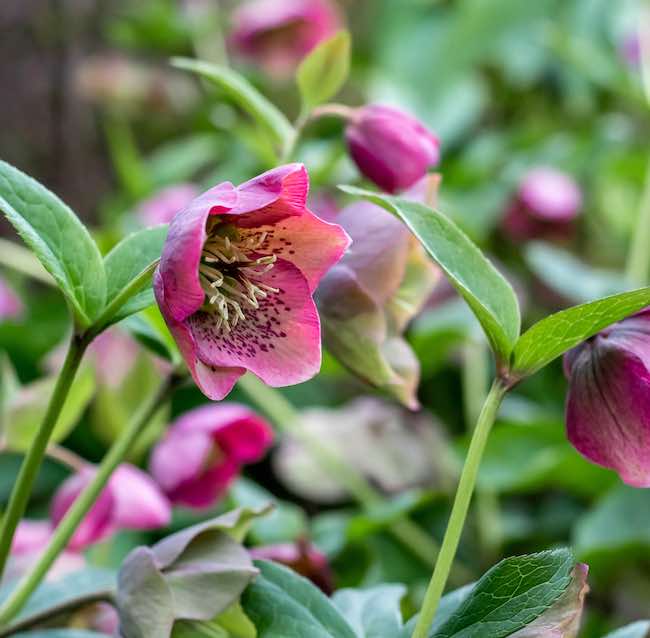How to add spring colour to your garden

The challenge with a spring garden is always to create colour in the early spring before the end of February.
Some popular perennials for adding colour and interest in spring in a UK garden are
- Forget-me-nots – Forget-me-nots are small, delicate flowers that belong to the Boraginaceae family. They typically have bright blue, five-petaled blooms and are a popular spring-blooming flower. The flowers are usually produced in clusters and sit atop delicate, hairy stems. The leaves are usually lobed or toothed and the plants often form low-growing mounds. Forget-me-nots are a popular choice for wildflower gardens, cottage gardens, and rock gardens due to their ease of growth and long-lasting blooms.
- Clematis armandii – Clematis armandii is a species of flowering plant in the family Ranunculaceae, native to western China. It is a woody, evergreen climber that produces fragrant, white flowers in early spring. The leaves are simple and leathery, and the plant is popular in gardens and landscapes as an ornamental plant.
- Hellebores – Helleborus are a genus of perennials in the family Ranunculaceae, native to Europe and Asia. They are commonly known as Lenten roses, due to the timing of their blooms around the Christian holiday of Lent. The flowers are usually cup-shaped and come in a range of colours, including white, pink, yellow, and green. The leaves are usually evergreen and provide interest in the garden year-round. Hellebores are popular as ornamental plants in gardens, and are prized for their early blooms and winter hardiness.
- Pulmonarias – Pulmonarias are a genus of perennials in the family Boraginaceae, native to Europe and Asia. They are also known as lungworts, due to the shape of their leaves, which are believed to resemble lung tissue. The flowers are usually bell-shaped and come in shades of blue, pink, and purple. The leaves are often spotted or marbled, adding further interest to the plant. Pulmonarias are popular in gardens for their shade tolerance and early spring blooms, and are often used as ground covers or as part of woodland gardens.
- Bergenia – Bergenia is a genus of perennials in the family Saxifragaceae, native to Asia. They are also known as ‘pigsqueaks’, due to the sound they make when the leaves are rubbed together. The leaves are large and leathery, and the flowers are produced in spikes and come in shades of pink or red. Bergenias are popular in gardens for their evergreen foliage and their ability to tolerate shady conditions, making them ideal for woodland gardens or as ground covers. They are also prized for their durability and low maintenance requirements.
- Aquilegias – Aquilegias, commonly known as columbines, are a genus of perennials in the family Ranunculaceae. They are native to temperate regions of the Northern Hemisphere. The flowers are showy and come in a range of colours, including blue, purple, pink, yellow, and red. The leaves are finely divided and form a basal rosette. Aquilegias are popular in gardens for their delicate appearance and their long-lasting flowers, which are attractive to hummingbirds. They are also prized for their ability to naturalise in woodland gardens.
- Anemones – Anemones are a genus of perennials in the family Ranunculaceae, native to temperate regions of the Northern Hemisphere. They are commonly known as windflowers. The flowers are showy and come in a range of colours, including white, pink, blue, and red. The leaves are finely divided and form a basal rosette. Anemones are popular in gardens for their delicate appearance and their long-lasting flowers, which bloom in the spring or autumn. They are also prized for their ability to naturalise in woodland gardens or meadows. Some species, such as the Japanese anemone, are also grown as cut flowers.
- Iris reticulata – Iris reticulata is a species of iris in the family Iridaceae, native to the Caucasus region of Eurasia. It is a small, bulbous plant that produces early spring blooms in shades of blue, purple, or yellow. The leaves are narrow and grass-like, and the plant is often grown in rock gardens or as a border plant. Iris reticulata is prized for its delicate beauty and is an early source of colour in the spring garden. It is also popular for its ease of cultivation and its ability to naturalise in suitable conditions.
- Primulas – Primulas are a genus of herbaceous flowering plants in the family Primulaceae. They are widely grown as ornamental plants and are native to the temperate Northern Hemisphere. They are known for their brightly coloured flowers, which bloom in shades of yellow, pink, red, and purple. Primulas are often grown in rock gardens, borders, and woodland gardens and are popular for their easy-to-grow nature and long-lasting flowers.
- Dicentras (Bleeding Hearts) – Dicentra is a genus of herbaceous perennials in the family Papaveraceae, also known as bleeding hearts. They are native to Asia and North America and are grown for their attractive, heart-shaped flowers which dangle from delicate stems. The flowers come in shades of pink, red, and white and bloom in spring and early summer. Dicentras are commonly grown in shady gardens and woodland settings, and are popular for their delicate beauty and graceful form.
- Snowdrops – Snowdrops (Galanthus) are a genus of herbaceous perennials in the family Amaryllidaceae. They are native to Europe and are among the first flowers to appear in late winter or early spring, often poking up through the snow. They have delicate, pendulous flowers with white petals and a green central “V” shaped mark. Snowdrops are popular for their early blooming period, ability to naturalise in suitable growing conditions, and their delicate beauty. They are often used in rock gardens, woodland gardens, and for naturalising in lawns and under trees.





















